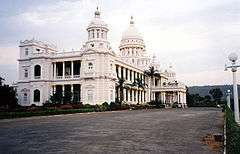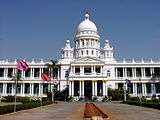Lalitha Mahal
| Lalitha Mahal, Mysore | |
|---|---|
 Lalitha Mahal, Mysore | |
 Location within Karnataka | |
| General information | |
| Architectural style | Renaissance Architecture |
| Town or city | Mysore |
| Country | India |
| Coordinates | 12°17′53″N 76°41′35″E / 12.298°N 76.693°E |
| Construction started | 1921 |
| Completed | 20th century |
| Cost | ₹1.3 million |
| Client | Krishnaraja Wodeyar IV, Mysore Kingdom |
| Technical details | |
| Structural system | Stone masonry and marble |
| Design and construction | |
| Architect | E.W. Fritchley |
The Lalitha Mahal is the second largest palace in Mysore. It is located near the Chamundi Hills, east of the city of Mysore in the Indian state of Karnataka. The palace was built in 1921 at the orders of His Highness Krishnaraja Wodeyar IV, the Maharaja of Mysore for the exclusive stay of the then Viceroy of India.[1] Built on a raising ground, the palace was fashioned on the lines of the St. Paul’s Cathedral in London and is one of the imposing structures of the Mysore city.[2][3][4][5]
The elegant palace is painted pure white. It was converted into a heritage hotel in 1974.[6] It is now run as an elite hotel of the Ashok Group of the India Tourism Development Corporation (ITDC) under the Government of India. However, a veneer of the original royal ambience of the palace is maintained.[1][3][7]
History
The palace dates from the early 20th century, built in the princely state of Mysore under the British rule. The principality was the labelled by the British Administrators as a "Model State”. The Maharajas of Mysore were wealthy, second only to the Nizams of Hyderabad. The palace, a very impressive architectural edifice, was constructed with a reasonable amount of money, out of their annual income of two million pounds.[1][2] The then Maharaja of Mysore of the princely state (since absorbed with the Indian state of Karnataka after India got independence from British rule) was HH Krishnaraja Wodeyar IV (June 4, 1884 - August 3, 1940) who ruled under the title “Wodeyar” with his capital in Mysore city. He was the 24th ruler of the Wodeyar dynasty. Mysore rulers were considered as great patrons of arts and architecture and were reasonably ostentatious in their living style, as is evidenced by the number of highly beautiful monuments consisting of palaces, temples, churches and gardens that they built to enhance the architectural heritage of their Kingdom. The Lalitha Mahal palace was built in 1921 for the exclusive stay of the then Viceroy of India and subsequently as guest house for the European guests of the Maharajas.[2][3]
Architecture
Set amidst sprawling landscaped gardens below the Chamundi hills, the palace was planned by E.W. Fritchley, the architect from Bombay (now renamed Mumbai) and constructed by B Munivenkatappa. The palace built in Renaissance architectural style is considered an adaptation of the St. Paul’s Cathedral in London, particularly the central dome. The architecture of the palace reflects English manor houses and Italian Palazzos. It is a two storied structure.[8] The supporting structure of the palace is of Ionic double column. At the ground level, there is a projecting porch. Spherical domes with the dominating central dome sets the front elevation of the palace. Decorative stained glass has been extensively used to enhance the elegance of the palace both in the exterior facades and in interiors doors, windows and ceilings. A lovely view of the Chamundi Hill to the left and the Mysore city in front of the palace is seen from the balcony upstairs.[3][9]
The palace has exquisitely designed viceroy room, a banquet hall, a dancing floor and an Italian marble staircase (has an arresting curve) and also embellished with small ornamentations, which are said to be replicas from various palaces in Britain. The full length portraits of the Wodeyar Kings, Italian marble floors and Belgian crystal chandeliers, cut glass lamps, heavy ornate furniture, mosaic tiles and a couple of exquisite Persian carpets gives the palace its regal ambience. With conversion of the palace into a heritage hotel, interiors have been modified to provide for modern conveniences but most of the earlier sections of the palace such as the dancing and banquet halls have been retained in their original elegance but adopted as dining halls and conference halls for holding meetings and conventions; these have polished wooden flooring and three stain glassed domes in the ceiling. The ball room in particular, which has been converted into the Dining Hall of the hotel, is a baroque hall with immensely high ceiling with domed skylights made of Belgian glass. A swimming pool is now an additional provision.[3][4][5] The elevator, carpeting and the Ottoman, upholstered with tapestry are treasured items in the palace.[10]

Gallery
 The Reception Hall of the Palace
The Reception Hall of the Palace The Grand Ballroom which is now the Dining Hall of Lalitha Mahal Palace Hotel
The Grand Ballroom which is now the Dining Hall of Lalitha Mahal Palace Hotel The main stairway made of Italian marble.
The main stairway made of Italian marble. The Ballroom - Three Domed skylights made of Belgian glass
The Ballroom - Three Domed skylights made of Belgian glass Lalitha Mahal Palace
Lalitha Mahal Palace Lalitha Mahal Palace
Lalitha Mahal Palace Lalitha Mahal Palace
Lalitha Mahal Palace Lalitha Mahal
Lalitha Mahal The Ottoman or Buggy
The Ottoman or Buggy Lalitha Mahal Hote
Lalitha Mahal Hote Garden from the terrace of the Lalitha Mahal Palace
Garden from the terrace of the Lalitha Mahal Palace Lalitha Mahal Hotel
Lalitha Mahal Hotel The Primary Stairway of the Palace and Porch
The Primary Stairway of the Palace and Porch
See Also
References
- 1 2 3 "About Lalitha Mahal". Retrieved 2010-01-02.
- 1 2 3 Cannadine, David (2002). Ornamentalism: How the British Saw Their Empire. Lalitha Mahal. Oxford University Press US. pp. 54–55. ISBN 0-19-515794-X. Retrieved 2010-01-02.
- 1 2 3 4 5 Raman, Afried (1994). Bangalore – Mysore. Mysore Palace. Orient Blackswan. pp. 87–88. ISBN 978-0-86311-431-1. ISBN 0-86311-431-8. Retrieved 2010-01-02.
- 1 2 "Palaces of Mysore: Lalitha Mahal Palace". Retrieved 2010-01-02.
- 1 2 Bruyn, Pippa de; Niloufer Venkatraman; Keith Bain (2006). Frommer's India. Lalitha Mahal Palace Hotel. John Wiley and Sons. pp. 266–267. ISBN 0-7645-9899-6. Retrieved 2010-01-02.
- ↑ "About Lalitha Mahal".
- ↑ "Lalitha Mahal Palace (A Heritage Ashok)". Ashok Group Hotels. Retrieved 2010-01-02.
- ↑ "Lalitha Mahal Palace Mysore". Retrieved 2010-01-02.
- ↑ "Lalith Manhal". Retrieved 2010-01-02.
- ↑ Bindloss, Joe; Sarina Singh (2007). India. Lalith Mahal. Lonely Planet. p. 900. ISBN 1-74104-308-5. Retrieved 2010-01-02.
| Wikimedia Commons has media related to Lalitha Mahal. |